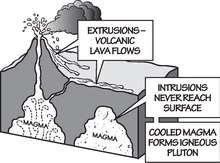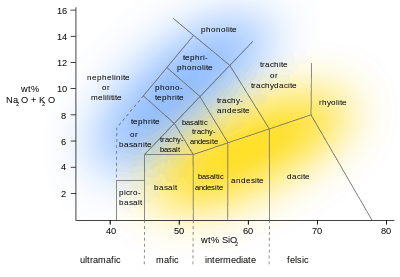Extrusive rock
Extrusive rock refers to the mode of igneous volcanic rock formation in which hot magma from inside the Earth flows out (extrudes) onto the surface as lava or explodes violently into the atmosphere to fall back as pyroclastics or tuff.[1] In contrast, intrusive rock refers to rocks formed by magma which cools below the surface.[2]


The main effect of extrusion is that the magma can cool much more quickly in the open air or under seawater, and there is little time for the growth of crystals.[3]Sometimes, a residual portion of the matrix fails to crystallize at all, instead becoming a natural glass or obsidian.
If the magma contains abundant volatile components which are released as free gas, then it may cool with large or small vesicles (bubble-shaped cavities) such as in pumice, scoria, or vesicular basalt. Other examples of extrusive rocks are rhyolite and andesite.
See also
References
- "Extrusive rock - geology". Retrieved 21 October 2018.
- Jain, Sreepat (2014). Fundamentals of Physical Geology. New Delhi, India: Springer. ISBN 9788132215394.
- Winter, John DuNann (2001). An Introduction to Igneous and Metamorphic Petrology. Upper Saddle River, New Jersey: Prentice-Hall. ISBN 0132403420.
- Schmincke, Hans-Ulrich (2004). Volcanism. New York City, New York: Springer-Verlag. ISBN 3540436502.
- Németh, Károly, Martin, Ulrike (2007). Practical Volcanology: Lecture Notes for Understanding Volcanic Rocks from Field Based Studies. Geological Institute of Hungary.
- Sen, Gautam (2014). Petrology : Principles and Practice. Berlin: Springer. ISBN 9783642388002. OCLC 864593152.
External links
| Look up extrusive in Wiktionary, the free dictionary. |